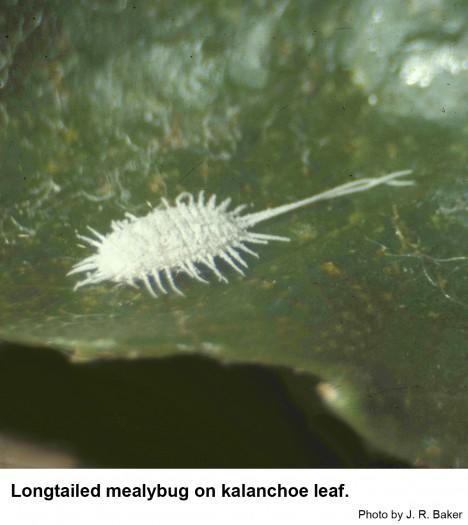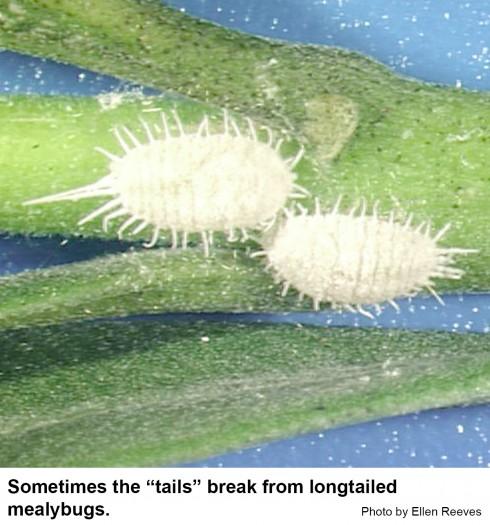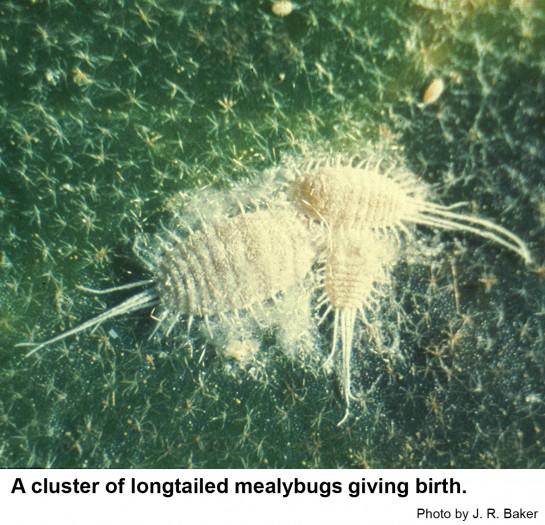Description and Biology
Female longtailed mealybugs, Pseudococcus longispinus, have 17 pairs of waxy filaments around the periphery and are up to 1/8 inch long. On mature specimens, the caudal (tail) filaments are as long as or longer than the yellowish to grayish body (unless the tail filaments have broken off). Overall length maybe 1/4 inch. Nymphs are similar to the larger adult female except that the filaments around the edges are shorter. Most species of mealybugs lay eggs in a dense, waxy mass called the ovisac, but the eggs of the longtailed mealybug hatch almost immediately so that they appear to be born alive. The males pupate in a fluffy cocoon of wax. Although longtailed mealybugs were first described in 1867, not much has been published on their biology. Females appear to give birth to live young on a shallow pile of white waxy secretions. Because the females are wingless, they must be brought into proximity of a host plant before it can be infested.
Host Plants and Damage
Longtailed mealybugs have been found on at least 26 plant families. Dracaena appears to be the favored host, but most flowering and ornamental foliage plants are susceptible. Mealybugs suck out sap and excrete honeydew, a sweet sticky liquid. The mealybugs, honeydew, male cocoons, and the ovisacs disfigure infested plants. Not only that, but as the mealybugs feed, they inject their saliva into the plant. Some very sensitive plants may wilt and die when large numbers of longtailed mealybugs are feeding.
Residential Recommendation
A small wasp, Anagyrus nigricornis, parasitizes longtailed mealybugs, and a small, predaceous, brown lacewing insect feeds on longtailed mealybugs. Longtailed mealybugs are sometimes difficult to control, even though there is no egg stage protected by a dense ovisac. If many plants are infested, they should be dipped or sprayed thoroughly with a pesticide mixture. Unless a systemic insecticide is used, it is best to re-treat two or more times at weekly intervals. Re-treatment will control mealybugs that were missed by earlier control efforts. If only a few plants are infested and the number of mealybugs is low, mealybugs can be removed with a cotton swab dipped in rubbing alcohol. The plant can then be washed with a mild soapy water to remove residual wax and honeydew left by the mealybugs (about 2% soap, not detergent). The plants must be observed closely for a few weeks and new mealybugs removed as they appear. Soaps labeled for use as insecticides for mealybug control on ornamental plants include Safer's, Citrusoap, and Olympic brands. These soaps are available from garden shops and plant centers. Insecticidal soaps are popular with some horticulturists because of their relative safety to people. Houseplant sprays and granular treatments are also available for home use. If labeled for mealybugs, they should give adequate control.
References
- Insect and related Pests of Flowers and Foliage Plants. Baker, J. R., ed. 1994. NC Cooperative Extension Service Publication AG-136. 106 pp.
- Mealybugs. Frank, S. D. and J. R. Baker. 2010. Entomology Insect Notes, NC State Extension Publications.
- Mealybugs of California. McKenzie, H. H. 1967. Univ. California Press. Berkely and Los Angeles. 525 pp.
- Extension Plant Pathology Publications and Factsheets
- Horticultural Science Publications
- North Carolina Agricultural Chemicals Manual
For assistance with a specific problem, contact your local Cooperative Extension Center.
This Factsheet has not been peer reviewed.
Publication date: Nov. 4, 2013
Reviewed/Revised: Sept. 27, 2022
Recommendations for the use of agricultural chemicals are included in this publication as a convenience to the reader. The use of brand names and any mention or listing of commercial products or services in this publication does not imply endorsement by NC State University or N.C. A&T State University nor discrimination against similar products or services not mentioned. Individuals who use agricultural chemicals are responsible for ensuring that the intended use complies with current regulations and conforms to the product label. Be sure to obtain current information about usage regulations and examine a current product label before applying any chemical. For assistance, contact your local N.C. Cooperative Extension county center.
N.C. Cooperative Extension prohibits discrimination and harassment regardless of age, color, disability, family and marital status, gender identity, national origin, political beliefs, race, religion, sex (including pregnancy), sexual orientation and veteran status.



